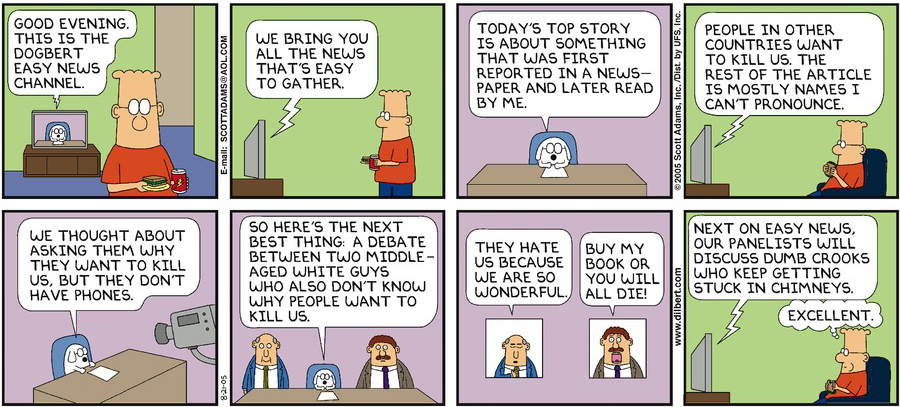print Print Cartoon
Questions
1. One of the types of humor editorial cartoonists use is irony. Irony is defined as when the opposite of what you expect to happen occurs. Describe the irony in Scott Adams’ cartoon.
2. An editorial cartoonist often uses humor to point out the absurd or ridiculous. Which comic device does the cartoonist use to make his point? Explain your answer.
a) caricature
b) satire
c) symbol
d) understatement
e) hyperbole
Scroll down to the bottom of the page for the answers.

Cartoon by Scott Adams
Answers
1. The reader understands that the cartoonist is making fun of “news” programs that don’t spend much time reporting on significant events and issues happening in the world. The irony is that you expect Dilbert to be annoyed/angry by the lack of real news on the news shows; instead he is happy and interested to watch the dumb criminals segment, which is not news at all.
2. b) satire – satire is defined as: the use of irony, sarcasm, ridicule, or the like, in exposing, denouncing, or deriding vice, folly, etc.
The cartoonist did not use:
a) caricature: A description or characterization that exaggerates or distorts a character’s prominent features, usually for purposes of mockery. For example, a cartoon of a gaunt Abraham Lincoln with a giant top hat, a very scraggly beard, and sunken eyes could be considered a caricature.
c) symbol: An object, character, figure, place, or color used to represent an abstract idea or concept.
Santa represents the Christmas shopping season; The turkey wearing a Pilgrim hat represents Thanksgiving and Uncle Sam represents in this case U.S. politics/presidential candidates
d) understatement: A figure of speech in which statements are purposely understated. It may be used to indicate the speaker’s nonchalance (or obliviousness) regarding an often important or otherwise remarkable situation. It often results in irony where, for instance, the speaker’s response to an event does not match how the viewer expects the speaker to react.
e) hyperbole: An extreme magnification or exaggeration of actuality. It blows something completely out of proportion for a distorted effect. The purpose of hyperbole is to create a larger-than-life effect and overly stress a specific point. (Used as a figure of speech in which exaggeration is used for emphasis or effect, as in “I could sleep for a year” or “This book weighs a ton”)
(Read the Dilbert comics Classroom Usage Statement)



